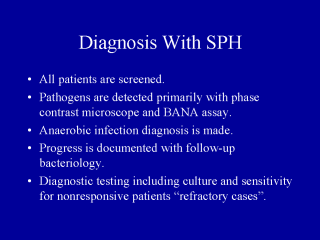|
|
|
|
front |1 |2 |3 |4 |5 |6 |7 |8 |9 |10 |11 |12 |13 |14 |15 |16 |17 |18 |19 |20 |21 |22 |review |
 |
Diagnosis with SPH – screening
guidelines
There is a need to have high quality predictive tests in order to be able to detect those patients who have active disease. This will become increasingly important if the recent studies associating gum disease with heart disease are confirmed. This is because gum disease as a risk factor for heart disease is modifiable (i.e. the infections can be treated and cured potentially eliminating the risk factor for heart disease). How do we do it in our clinic? Take four dental plaque samples, split between BANA and microscope slide wet mount preparation. IDHF and Oratec representatives can prepare you to do this technique properly. We do the bacteriology on all adult patients on their first visit. Children with gingivitis have bacteriologic screening on their first visit. The total time taken for this testing is 5 minutes with explanations to patients taking an additional 15 minutes. Diagnosis of anaerobic infection is critical to assess who needs treatment. The historical diagnostic tests have little or no prognostic value. Not all pockets are equivalent. A pocket with healthy plaque is OK since the disease will arrest when the pathogens are gone. For nonresponsive or "refractory" cases, it may be useful to use culture and sensitivity although I have found this to be an impractical path to take due to high cost to the patient and the fact that metronidazole will effectively treat most anaerobes. I would suggest utilizing culture and sensitivity only on refractory cases at the doctors discretion. |